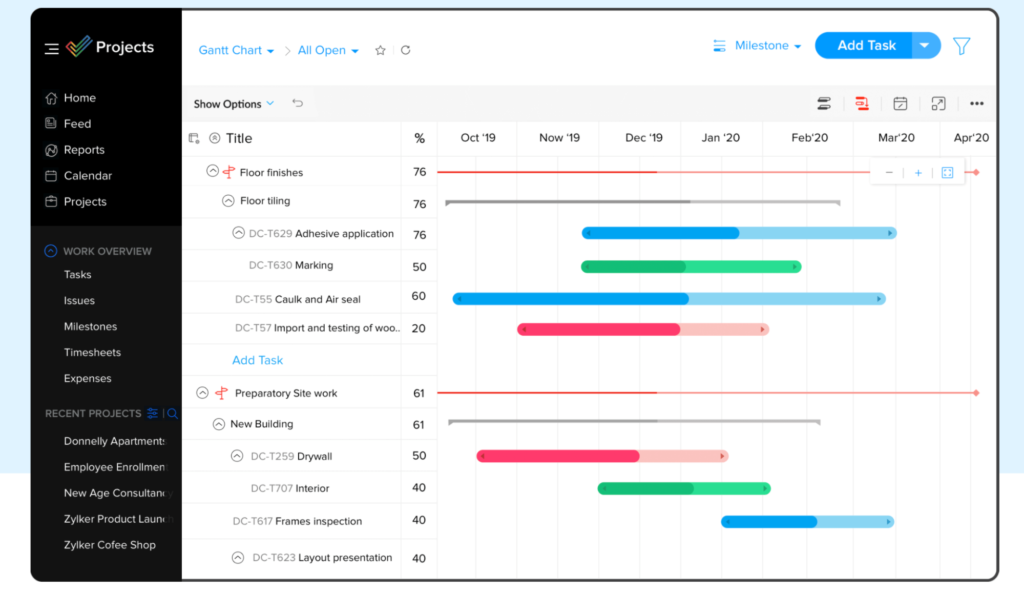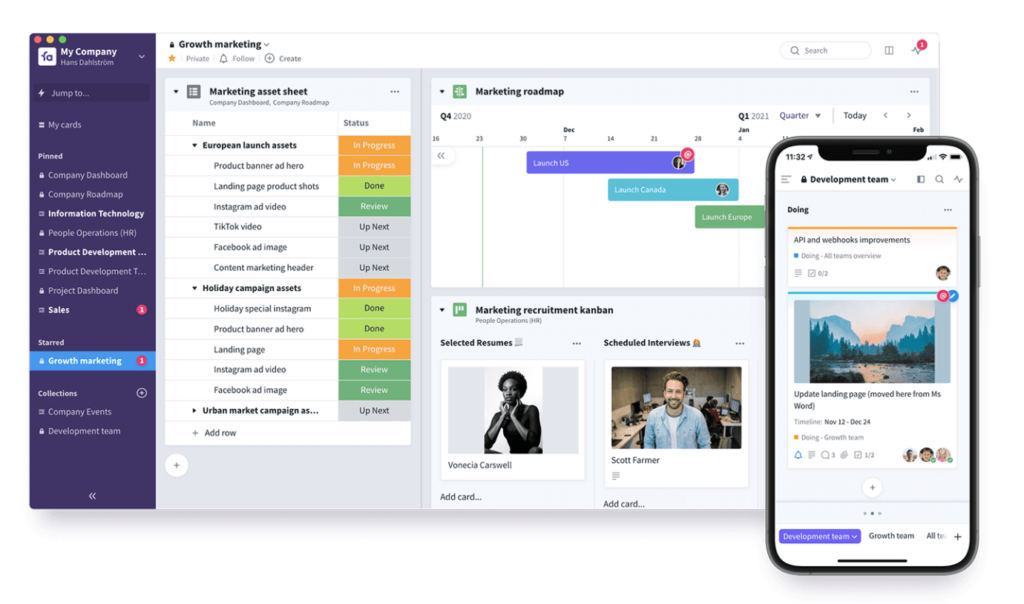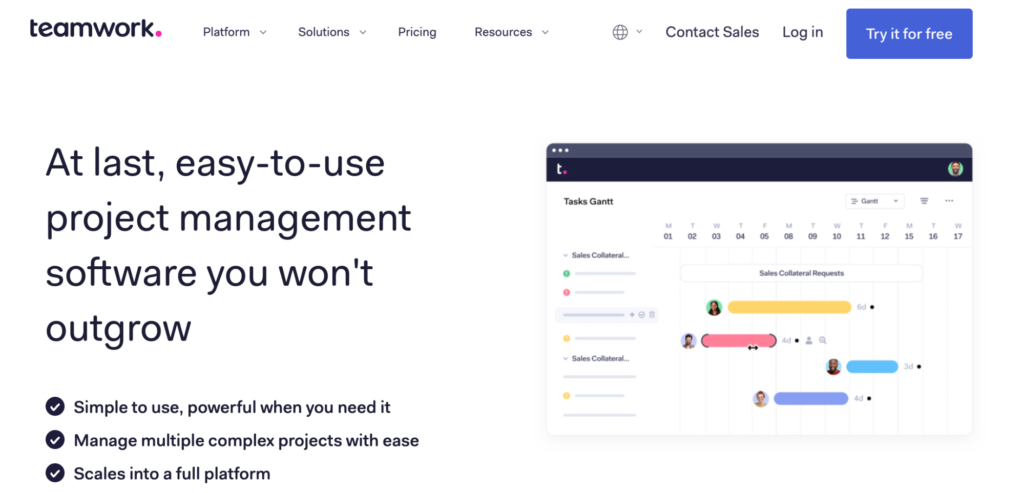At its core, project management is all about execution. From small projects to large, complex, and everything in between, proper execution comes down to following the right process.
Project managers need to do much more than just remind their teams about deadlines and upcoming meetings—they must have a firm grasp of the entire project life cycle.
This guide will dive into the different phases and processes of a project. It will ultimately help beginners and experienced project managers alike improve their management skills and deliver better results.
What is the Project Management Process?
There are lots of different project management methodologies. But regardless of the method in place, all projects have two things in common—projects are completed in phases and follow an established process through each stage.
According to the Project Management Institute (PMI), there are five project management processes:
- Project Initiation
- Project Planning
- Project Execution
- Project Monitoring and Controlling
- Project Closing
Understanding these systematic elements as a whole will help project managers determine what must be accomplished before moving to the next stage in the process.
4 Tools to Improve Your Project Management Process
The best project managers rely on tools to ensure the project management process runs smoothly. Whether you’re a complete beginner or experienced manager, these are the top tools that you should take into consideration:
#1 — Zoho Projects
Zoho Projects is one of the most powerful and flexible project management tools on the market today. It’s used throughout projects for construction, marketing, software development, education, consulting, testing, real estate, and a wide range of other industries. The software has everything you could possibly need to manage the project life cycle and collaborate with your team, regardless of their location.
The tool comes with an intuitive user interface and integrates with dozens of third-party business apps that your organization uses on a regular basis. It comes with features for task management, time tracking, reporting, dependencies, and more. Use it to manage sprints and see a complete overview of your total project portfolio. There’s a free version of Zoho Projects that supports up to three users. Most companies sign up for the Premium package, at a minimum. Paid plans start at $5 per user per month. Try Zoho Projects for free with a 10-day trial.
#2 — Favro
Favro isn’t quite as well known as some of the other project management tools out there. It’s an all-in-one solution for collaborative planning for agile teams. The software is flexible enough to accommodate the needs of marketing teams to software developers. From backlog management to sprint planning, Favro has it all. It’s an excellent solution to solve problems associated with remote work. Your entire team will benefit from its real-time collaboration features.
Overall, the tool is packed with features to simplify the project management process. It comes with solutions for project roadmaps, project scheduling, team planning, and more. Favro integrates with popular tools like Slack, Google Drive, Jira, Zapier, and other useful business apps. The software works best for smaller teams using agile project management. Plans start at $10.20 per month, and you can try it free for 14 days.
#3 — Teamwork
Teamwork is trusted by 20,000+ businesses and 6,000+ agencies across the globe. Big brands like Netflix, HP, Panasonic, PayPal, Spotify, and Disney all rely on Teamwork for project management. The software is the perfect balance between simple and powerful. It’s easy for non-technical users to figure out but packed with features to accommodate a wide range of needs and use cases.
Compared to other tools on the market, Teamwork really stands out from the crowd with its project portfolio management tools. For project managers that oversee multiple projects simultaneously, this software makes it easy to implement and track the process of each one through a single source of truth. It comes with tools for time tracking, task management, resource management, reporting, and more. You can integrate Teamwork with QuickBooks, Zapier, Dropbox, Xero, HubSpot, and other tools that you’re already using. The software is free forever for up to five users, and paid plans start at $10 per month. Try Teamwork for free with a 30-day trial.
#4 — Wrike
Wrike is another popular solution in the project management category. It’s used by 20,000+ organizations, including household names like Airbnb, Dell, and Google. I like Wrike because it’s so versatile. The same software can be used to accommodate marketing teams, professional services organizations, product development teams, creative teams, and more. It’s used for project management, resource management, agile project management, remote work, and plenty of other use cases.
One of the reasons why Wrike is so popular is due to its advanced workflow automations. This helps streamline the project management process from start to finish. Wrike also has solutions that leverage AI for risk prediction. This is a huge component of managing crucial stages within any project. Small teams of up to five users can use Wrike for free. But to get the most out of this software, you’ll definitely want to sign up for a premium plan. Those start at $9.80 per user per month. Try Wrike for free with a 14-day trial.
The Basics of the Project Management Process
As previously mentioned, there are five phases in the project management process. We’ll discuss each one in greater detail below.
Project Initiation
The first stage in the project management process is initiation. In this phase, project managers must define the project scope at a broad level. You’ll need to find a way to turn an idea into a tangible goal.
The budget, estimated timeline, goals, and project constraints will all be defined during the project initiation. Key stakeholders will be identified, and the project team will be determined as well.
Arguably the most important part of the initiation phase is feasibility. PMs must remove vagueness from the idea, so clear end goals can be established. You won’t be diving into any technical details of the project just yet, but the general overview has to get clarified.
For example, let’s say a manufacturing facility is tasked with building an electric scooter. The design, battery, and other details will not be established in the initiation phase. The only certainty here is that an electric scooter will be built within a specific time and budget.
Project Planning
The project planning phase of the process is a bit more in-depth. Now it’s time to establish a project roadmap.
Project managers are tasked with creating a project schedule and identifying the technical aspects of what needs to happen. This includes tangible goals and deliverables. Regardless of the project management methodology in place, project planning is arguably the most important part of the project management process. This step lays the foundation for the rest of the phases, so don’t cut corners or take this lightly.
By the end of this phase, the project manager should have a detailed blueprint that explains the entire project from inception through completion.
Planning also involves risk mitigation. Project managers need to identify potential risks and develop a plan to minimize those problems, should any issues arise. Put some contingencies in place and be ready to implement changes that can prevent bottlenecks and delays down the road.
The final part of project planning is establishing a communication plan with stakeholders. From status updates to general input and regular meetings, all of this will be identified during the planning phase.
Project Execution
The project execution phase is when the project team puts the plan into action. It’s the stage in the project management process where the actual work gets completed.
It’s the project manager’s job to establish a methodology and workflow for the team to follow. Stakeholders don’t need to be bothered with these details, but the management methodology will define clear guidelines for the entire team.
Project managers will communicate with stakeholders on a regular basis throughout the execution process, on a schedule previously defined during the planning stage. This helps ensure that everyone is on the same page and the project runs according to plan.
Project management and team collaboration software make this much easier for everyone involved. It’s the best way for project managers to boost their team’s productivity while keeping everyone in the loop.
Let’s jump back to the electric scooter example. During the execution phase of this project, the scooter will be developed from start to finish.
Project Monitoring and Controlling
The monitoring and controlling process of project management actually runs parallel with the execution stage. Project managers use this to ensure tasks are completed on time and deliverables are met.
Depending on the project management methodology in place, managers have different ways to ensure that nobody on the team is deviating from the original plan.
For example, if you’re using an agile methodology like Scrum, you might hold daily standup meetings as a way to monitor what your team is working on.
Project managers must also track the costs and resources being used throughout the project. This helps ensure that everything is being completed within the predefined budget.
Project Closing
The last stage of the project management process is the closing. This is when the project ends after its final delivery.
If you’ve hired third-party contractors or outside help to complete the project, those contracts will be terminated during this phase. All paperwork and filing to indicate the end of the project will happen during the closing process as well.
It’s essential for project managers to hold a final meeting with their team after the project completion. This is a great opportunity for everyone to reflect on the project to determine what went well and what needs improvement. Closing meetings help improve the performance and productivity of teams as they work on future projects together.
Project managers should also complete a final report of the project covering all of the details from start to finish. This report will be kept on file so anyone within the organization can access it at a later date.
3 Tricks For Project Management Process
The project management process is very involved. But in my experience, these quick tricks will make your life much easier.
Trick #1: Use Project Management Software
Running a project without PM software in today’s day and age is essentially setting up your team for failure. There are so many moving parts throughout the project management process that keeping track of everything without software is unrealistic and inefficient.
As a project manager, you can use this software to create a project timeline, track your budget, assign tasks to your team, and monitor progress. Project management software is also the best way to run reports and share updates with stakeholders.
In addition to the tools listed earlier in this post, check our complete list of the best project management software on the market today.
This guide also contains helpful resources on how to choose the right project management software for your unique situation. Regardless of your project scope or the project management methodology you’re using, the guide has something for everyone.
Trick #2: SMART and CLEAR Goal Planning
As previously stated, the project planning phase is arguably the most important stage within the project management process. But taking a broad idea and turning it into a tangible goal is easier said than done.
To simplify this step, I recommend using SMART or CLEAR goal planning. These are two acronyms that can help you clearly define intentions and purpose.
SMART stands for:
- Specific
- Measurable
- Attainable
- Realistic
- Timely
CLEAR stands for:
- Collaborative
- Limited
- Emotional
- Appreciable
- Refinable
By working these goal-setting methods into your project planning, it can help you define your project scope much faster, in a way that’s clearly communicated with your team and stakeholders.
Trick #3: Think Big-Picture
Lots of project managers fail because they put too much attention on smaller details of the project that should ultimately be handled by the project team.
While it’s still your job to establish the process, timeline, and tasks associated with execution, you shouldn’t be putting all of your efforts into how each team member is completing their tasks. Let your team hold themselves accountable for their work. Project managers should act as a resource if team members run into issues or have a problem.
Micromanaging is ineffective, and your time will be better spent focusing on the big picture of the project. This helps ensure that resources are allocated effectively and the project is completed on time while staying within budget.
from Quick Sprout https://ift.tt/3cKcY1k
via IFTTT



